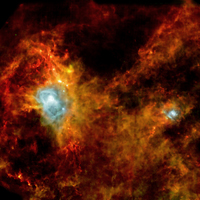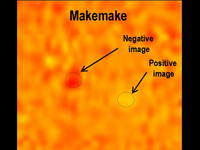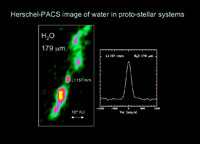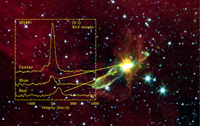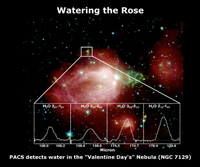Initial results from Herschel's science demonstration phase
21 December 2009
Initial results from the Herschel science demonstration phase have been presented by and to the scientific community at a recent workshop. Both SPIRE and PACS instruments have been tested to their full capabilities and have passed the tests with flying colours. Initial science results include the first image of a previously hidden region of star formation, observations of one of the coldest objects in the Solar System, and new perspectives on the highly energetic processes in the environments of newborn stars.As the science demonstration phase of the Herschel mission draws to a close the preliminary results from this phase have been presented by and to the scientific community at a two day workshop organised by the Herschel Science Centre and held 17-18 December 2009 at the Universidad Politénica de Madrid in Boadilla del Monte, in Spain. The purpose of the workshop was to demonstrate the science capabilities of the Herschel observatory by performing a small subset of the observations from the approved Key Programmes. The results are being used to optimise, where appropriate, the forthcoming routine science operations phase.
Some of these initial results are summarised below.
Presentations from the meeting can be downloaded from the dedicated workshop page (see link in right-hand menu).
|
Makemake: a cool dwarf planet is more complex than expected Key Programme: TNOs are cool: a survey of the trans-Neptunian region One of the coldest known objects in our Solar System has been observed with SPIRE. Makemake, a dwarf planet, appeared much fainter than had been predicted and may be much more complex than had been expected.
Makemake is the third largest dwarf planet known, with a diameter of around 1500 km. It is currently nearly 8 billion km from the Sun and with a surface temperature of around 30 Kelvin (-240 °C) is one of the coldest objects in the Solar System making it very hard to detect. By taking images with SPIRE 44 hours apart and subtracting the 'before' image from the 'after' image, the background sky is removed. Makemake, having moved in the intervening time, appears twice in the resulting image: once as a 'negative image' and again as a 'positive image'. This result demonstrates the sensitivity of this technique to such faint objects.
|
|
Water as a powerful probe of energetic interactions Key Programme: Water In Star-forming regions with Herschel (WISH) Water has been detected in three young stellar objects observed with PACS during the Herschel Science Demonstration Phase. These are from a sample of almost 90 young stellar objects that will be observed as part of the Water In Star-forming regions with Herschel (WISH) key programme. WISH will investigate the physical and chemical structure of star forming regions by focussing on the distribution of water and its related species in regions in which new stars are forming. This process takes place deep inside dark clouds and cannot be studied at optical wavelengths. Spectroscopy with HIFI and PACS provide the best diagnostic tools for this type of investigation.
Young stars produce powerful jets during their birth, in a process which is not yet fully understood. In the first PACS observations of L1157 (a low mass young stellar object comparable to our Sun when it was a toddler), the water distribution in the environment of this young protostar clearly traces regions along the jets where shocks deposit energy into the clouds surrounding the protostar. This is the first water map of such a region and beautifully illustrates the power of PACS to 'light up' the interaction of the young star with its surroundings. Herbig-Haro 46, a classic example of a low mass young stellar object, was also observed with PACS. Here, the forbidden excitation lines of [OI] were resolved showing that most of this emission is found along the outflow in the high velocity jets. These [OI] lines, which can only be resolved with Herschel, trace regions of shock-excited gas. Strong water lines were also detected in NGC 7129 (an intermediate mass young stellar object), along with other related trace lines (OH, CO and [OI]). These new observations challenge the current models describing the environment of this object. The first preliminary results of this small sample of the WISH objects have clearly demonstrated the power of Herschel to probe these poorly understood regions and the role of water in shaping them.
|
Most of the performance verification and science demonstration phase activities have been completed for SPIRE and PACS, and both instruments will commence routine operations before the year ends. The third instrument HIFI has remained switched off following an anomaly on 2 August 2009. It has recently been switched on again and operators are proceeding with the performance verification of this instrument with a view to beginning the science demonstration phase in late January 2010.
Herschel First Results Symposium, 4-7 May 2010ESLAB 2010, a symposium dedicated to the first science results from Herschel, will take place from 4 to 7 May 2010 at ESTEC, Noordwijk, The Netherlands. Registration and detailed information will be announced in January 2010. For summary information see the ESLAB 2010 symposium information page (link on right-hand menu).

